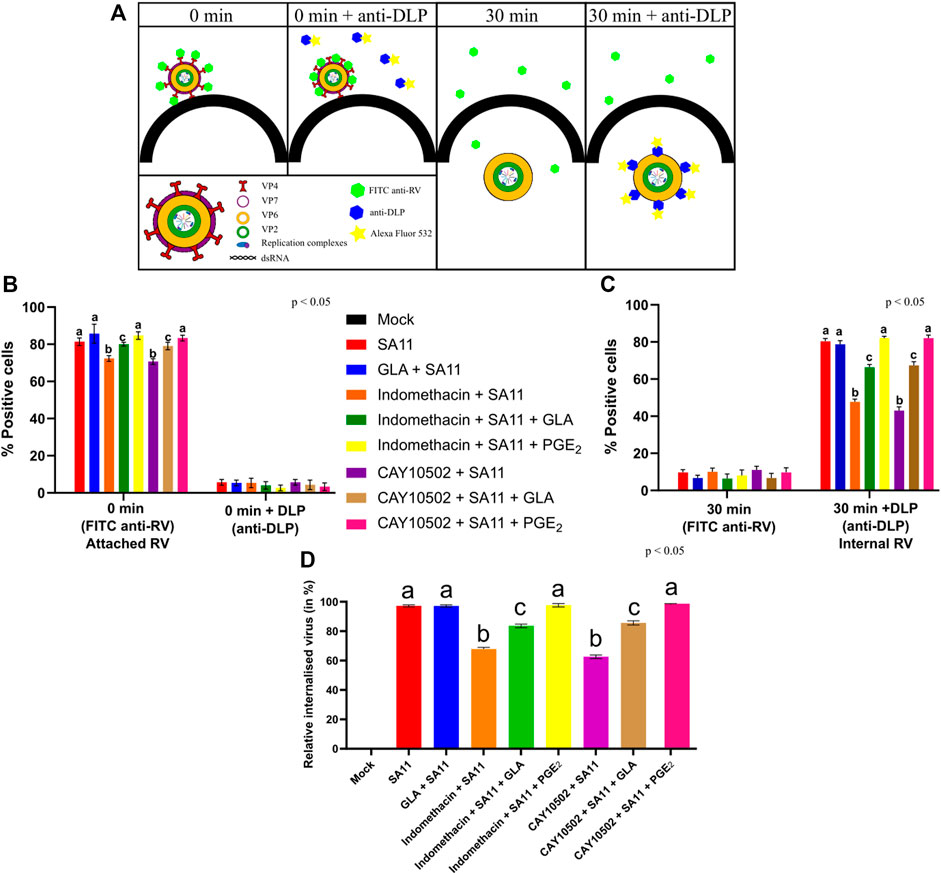
95% of researchers rate our articles as excellent or good
Learn more about the work of our research integrity team to safeguard the quality of each article we publish.
Find out more
CORRECTION article
Front. Physiol. , 19 April 2022
Sec. Lipid and Fatty Acid Research
Volume 13 - 2022 | https://doi.org/10.3389/fphys.2022.901082
This article is a correction to:
Rotavirus-Mediated Prostaglandin E2 Production in MA104 Cells Promotes Virus Attachment and Internalisation, Resulting in an Increased Viral Load
A Corrigendum on
Rotavirus Mediated Prostaglandin E2 Production in MA104 Cells Promote Virus Attachment and Internalisation, Resulting in an Increased Viral Load
by Sander WJ, Kemp G, Hugo A, Pohl CH and O’Neill HG (2022). Front. Physiol. 13:805565. doi: 10.3389/fphys.2022.805565
In the original article, there was a mistake in Figure 5A as published. In the figure, the rotavirus outer capsid proteins are labeled incorrectly. The spike protein is VP4 and the outer layer protein, VP7, not VP7 and VP4, respectively, as in the published article. The corrected Figure 5A appears below.

FIGURE 5. Inhibition of PGE2 biosynthesis affects RV attachment and internalisation. (A) At time zero, RV at an MOI = 10 is cold-bound to MA104 cells and is visualised by anti-RV-FITC labelling, which detected the outer capsid protein VP7. When labelling with anti-double-layered particle (DLP) is applied, virus at the cell surface cannot be detected as the antibodies target the middle-layer protein, VP6, which is only accessible after the outer layer has been shed. Thus, the signal intensity of 0 min + anti-DLP is strongly reduced compared to 0 min + anti-RV due to the inability to detect VP6. When the temperature is increased, RV is internalised and the loss of the outer capsid allows for the detection of VP6, i.e., DLPs, to be accessible for staining. (B) Graph showing a higher positive detection of anti-RV-FITC compared to anti-DLP at 0 min. (C) Graph showing a higher positive detection of anti-DLP compared to anti-RV-FITC at 30 min. (D) Relative percentage of internalised virus from untreated and inhibitor-treated cells at 30 min post-infection is calculated by dividing the relative internalised RV (30 min) (C) by relative attached RV (0 min) (B). Error bars indicate the standard error of the mean (n = 3). Lowercase letters indicate significant differences (p < 0.05) compared to the control.
The authors apologize for this error and state that this does not change the scientific conclusions of the article in any way. The original article has been updated.
All claims expressed in this article are solely those of the authors and do not necessarily represent those of their affiliated organizations, or those of the publisher, the editors and the reviewers. Any product that may be evaluated in this article, or claim that may be made by its manufacturer, is not guaranteed or endorsed by the publisher.
Keywords: rotavirus, viroplasm, prostaglandin E2, fatty acid supplementation, internalisation, attachment, lipid droplets
Citation: Sander WJ, Kemp G, Hugo A, Pohl CH and O'Neill HG (2022) Corrigendum: Rotavirus-Mediated Prostaglandin E2 Production in MA104 Cells Promote Virus Attachment and Internalisation, Resulting in an Increased Viral Load. Front. Physiol. 13:901082. doi: 10.3389/fphys.2022.901082
Received: 21 March 2022; Accepted: 28 March 2022;
Published: 19 April 2022.
Edited and reviewed by:
Luigi Iuliano, Sapienza University of Rome, ItalyCopyright © 2022 Sander, Kemp, Hugo, Pohl and O'Neill. This is an open-access article distributed under the terms of the Creative Commons Attribution License (CC BY). The use, distribution or reproduction in other forums is permitted, provided the original author(s) and the copyright owner(s) are credited and that the original publication in this journal is cited, in accordance with accepted academic practice. No use, distribution or reproduction is permitted which does not comply with these terms.
*Correspondence: Hester G. O'Neill, b25laWxsSEdAdWZzLmFjLnph
Disclaimer: All claims expressed in this article are solely those of the authors and do not necessarily represent those of their affiliated organizations, or those of the publisher, the editors and the reviewers. Any product that may be evaluated in this article or claim that may be made by its manufacturer is not guaranteed or endorsed by the publisher.
Research integrity at Frontiers

Learn more about the work of our research integrity team to safeguard the quality of each article we publish.